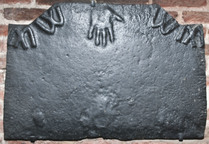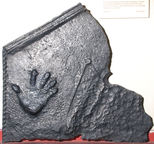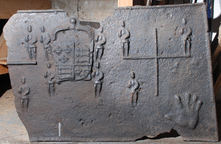-
1113
Description: Quasi-rectangular with a three-facetted arch; top centre, left hand print; around each shoulder, M W mirrored.
Notes: The likelihood is that the M and W are formed of a double-V (virgo virginum) intended to symbolise the Virgin Mary and have an apotropaic (evil-averting) purpose. It may be of significance that hand prints seen on firebacks are always of the left hand.
Inscription: MW WM
- Decoration tags:
- rectangular with triple-facetted arch (shape)
- none (edging)
- simple stamps
- individual letters
- apotropaic
- text
- humans
Manufactured: in the early-17th century possibly in the Weald area of England.
Current location: in private hands, Crowborough, East Sussex, England.
- Attached to series:
- Hand print firebacks
-
60
Description: Fragment; rectangular; flanged top edge; probable symmetrical arrangement of crowned Tudor royal shield stamps (4 above 3); vertical line on either side of each shield; left hand print in bottom left corner, probably mirrored on right.
Notes: The right side of the fireback is missing. Very crude modelling of stamp suggests an early date; the same crowned shield and use of hand print can be seen on a fireback at Rolvenden (no. 661), indicating a common source..
- Decoration tags:
- rectangular (shape)
- flanged (edging)
- simple stamps
- carved stamps
- heraldic
- humans
Manufactured: in the early- to mid-16th century in the Weald area of England.
Current location: in private hands, Etchingham, East Sussex, England.
- Attached to series:
- Hand print firebacks
- Early Tudor series
- Tudor royal armorial firebacks
-
73
Description: Plain rectangular plate; print of a left hand, lower centre.
Notes: The excrescence above and to the left of the hand print shows where the pouring iron displaced the casting sand.
- Decoration tags:
- rectangular (shape)
- none (edging)
- simple stamps
- humans
Manufactured: in the 16th century in the Weald area of England.
Current location: in private hands, Groombridge, Kent, England.
- Attached to series:
- Hand print firebacks
-
370
Description: Fragment; left side only; twisted rope edging to left, canted moulded batten above; left hand print with dividers to its right.
Notes: An unusual combination of edging. The dividers may refer to the occupation of the person for whom this fireback was cast. Formerly in the collection of Dr C. L. Prince of Crowborough, Sussex.
- Decoration tags:
- rectangular with canted top corners (shape)
- rope and wood moulding (edging)
- simple stamps
- humans
- objects
Manufactured: in the mid- to late-16th century in the Weald area of England.
Current location: Anne of Cleves House, Southover High Street, Lewes, East Sussex, England.
Museum number: LH000.798 (part of the Sussex Archaeological Society museum group)
Citation: Anon., 30 Dec 1911, 'Sussex Backs and their Story', The Ironmonger.
Citation: Dawson, C., 1903, 'Sussex Iron Work and Pottery', Sussex Archaeological Collections, 46, pp. 1-54.
Citation: Gardner, J. S., 1898, 'Iron Casting in the Weald', Archaeologia, 56, 1, pp. 133-164.
- Attached to series:
- Hand print firebacks
- Metalware stamp firebacks
-
661
Description: Fragment; quasi-rectangular; twisted rope edging (top and sides), cavetto edging at bottom; originally, probably a symmetrical arrangement comprising a central, crude crowned, Tudor royal shield, with a standing human figure, its right arm bent at the elbow and its left arm crossing its waist, repeated in upper and lower positions on each side of the shield; to left and right, a twisted rope length repeated in the form of a cross, with the human figure placed above each transverse end and another below the cross and towards the shield; in the bottom corner(s), a (left) hand print.
Notes: The same crowned shield and use of hand print can be seen on a fireback at Etchingham (no. 60), indicating a common source.
Arms: Tudor royal
- Decoration tags:
- rectangular (shape)
- simple stamps
- carved stamps
- armorial
- royal
- humans
- objects
Manufactured: in the early- to mid-16th century in the Weald area.
Current location: Hole Park, Rolvenden, Kent, England.




